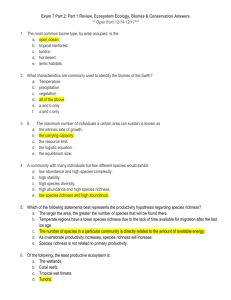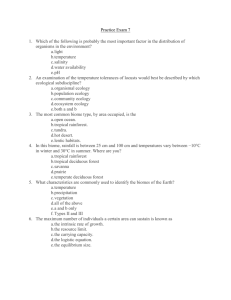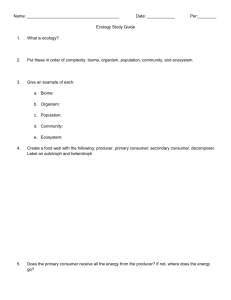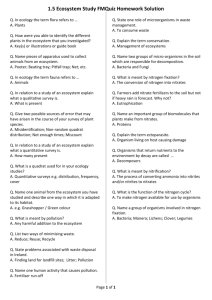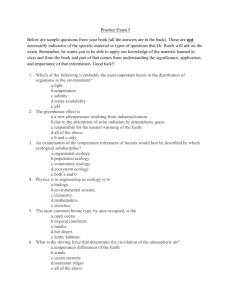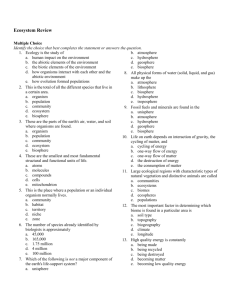12-10-15 Exam 7 Part 2 Questions
advertisement
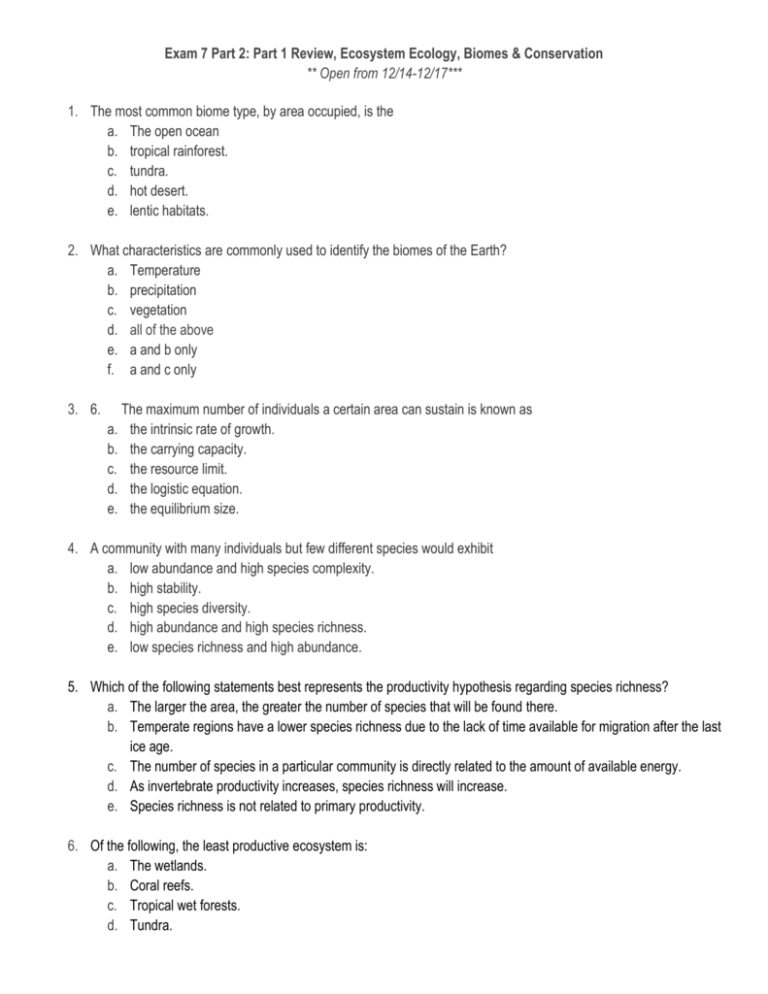
Exam 7 Part 2: Part 1 Review, Ecosystem Ecology, Biomes & Conservation ** Open from 12/14-12/17*** 1. The most common biome type, by area occupied, is the a. The open ocean b. tropical rainforest. c. tundra. d. hot desert. e. lentic habitats. 2. What characteristics are commonly used to identify the biomes of the Earth? a. Temperature b. precipitation c. vegetation d. all of the above e. a and b only f. a and c only 3. 6. The maximum number of individuals a certain area can sustain is known as a. the intrinsic rate of growth. b. the carrying capacity. c. the resource limit. d. the logistic equation. e. the equilibrium size. 4. A community with many individuals but few different species would exhibit a. low abundance and high species complexity. b. high stability. c. high species diversity. d. high abundance and high species richness. e. low species richness and high abundance. 5. Which of the following statements best represents the productivity hypothesis regarding species richness? a. The larger the area, the greater the number of species that will be found there. b. Temperate regions have a lower species richness due to the lack of time available for migration after the last ice age. c. The number of species in a particular community is directly related to the amount of available energy. d. As invertebrate productivity increases, species richness will increase. e. Species richness is not related to primary productivity. 6. Of the following, the least productive ecosystem is: a. The wetlands. b. Coral reefs. c. Tropical wet forests. d. Tundra. 7. According to the competitive exclusion hypothesis, a. two species that use the exact same resource show very little competition. b. Two species with the same niche cannot coexist c. one species that competes with several different species for resources will be excluded from the community. d. all competition between species results in the extinction of at least one of the species. e. none of the above is correct. 8. NPP can be defined as: a. The amount of chemical energy, stored by autotrophs, that is available for heterotrophs b. Photosynthesis – respiration carried out by the primary producer c. Gross primary production. d. All of the above. e. A & B 9. Chemoautotrophic bacteria are a. primary producers b. primary consumers. c. secondary consumers. d. tertiary consumers. e. decomposers. 10. Carbon enters primary producers as CO2 from: a. The soil b. The atmosphere c. Plant tissue d. Other primary decomposers 11. When considering the average food chain, which of the following statements is true? a. Secondary consumers are the most abundant organisms in an ecosystem. b. The more lengths in the food chain, the more stable the ecosystem. c. Biomass decreases as you move up the food chain. (The total mass of organisms in an area decrease as you work your way up a food chain) d. The trophic level with the highest species abundance is usually the primary producers e. All of the above are true. 12. Primary production in aquatic systems is limited mainly by a. temperature and moisture. b. temperature and light. c. temperature and nutrients. d. light and nutrients. e. light and moisture. 13. The net primary production of cultivated land is closest to that of a. tropical rain forest. b. wetlands. c. prairies. d. temperate deciduous forest. e. lakes and streams. 14. Nitrogen fixation is the process: a. that converts organic nitrogen to ammonia. b. by which plants and animals take up nitrates. c. by which bacteria convert nitrate to gaseous nitrogen. d. by which atmospheric nitrogen is converted to ammonia or ammonium ions (NH4+). e. all of the above 15. Disturbances, such as logging, can decrease the loss of nitrogen from the ecosystem. a. True b. False 16. Of the following, which chemicals include a naturally occurring gaseous form in nature? a. Calcium b. Potassium c. Phosphorus d. Sulfur 17. Which of these factors is not generally correlated with species diversity? a. Latitude b. Productivity c. Longitude d. Gene pool diversity 18. Which of the following ecosystems would you expect to have the highest primary production? a. Subtropical desert b. Temperate grassland c. Boreal forest d. Tropical rainforest 19. Most of the net primary productivity that is consumed is used for what purpose? a. Respiration by primary consumers b. Respiration by secondary consumers c. Growth by primary consumers d. Growth by secondary consumers 20. Lowered oxygen levels in the water due to nitrogen fixation is called: a. Speciation b. deoxygenation c. eutrophication d. abiotic pressures 21. List the four ecosystem services and be sure to provide examples of each: 22. “The climate of a given region plays a major role in determining what types of organisms live there; and the abundance of those organisms.” This defines which of the following terms? a. Biome b. Ecosystem ecology c. Turbidity d. Global ecology 23. Ecosystem Ecology focuses on two critical processes. List and describe them below. 24. The ________ is the most important distinguishing characteristic for defining Terrestrial biomes. a. Latitude b. Climate c. Type of vegetation present d. The organisms present 25. What is Iowa’s local biome? Describe it. 26. Iowa has been the site of many different biomes throughout the Earth’s history. a. True (shallow ocean, glacier, tundra, grassland) b. False 27. Primary producers (“autotrophs”) convert chemical energy into light energy. a. True b. False (flipped) 28. Define the following terms: a. Omnivoresb. Carnivoresc. Herbivoresd. Heterotrophse. Autotrophs29. List 4 examples of conservation efforts: 30. Why is it significant that much less energy is available to sequentially higher trophic levels of organisms within a food chain? 31. Populations tend to be quite small for large predators because they are “high on the food chain”. a. True b. False 32. Based on the current available data, is there evidence to support the conclusion that human activates are causing global climate change? Explain why or why not.

